Windows
Overview
Windows are an integral part of a house’s aesthetics. Although old windows in poor condition are also a detraction from the house’s appearance, this section will focus mainly on the energy value of windows.
Poor windows in an otherwise fairly well insulated house can account for at least 1/2 of the total heat loss/cost. At the other extreme are well built and installed windows that actually gain more energy than they loose. Solar Gain (sunshine) can substantially reduce heating costs, even in “cloudy” climates.
Passive Solar Home Designs – windows placed on the south side of the home and reduced windows in other directions, can cost less than 1/2 as much to heat as houses with mostly north-facing windows, when all other conditions are the same.
Residential windows used to be all wood framed with a single glass pane. Then storm windows came along, which were an improvement for energy, but have many functional problems. Today, thermal pane windows (shown above) are not only a minimum requirement by most codes, they are also the minimum quality window made by most manufacturers.
When selecting windows for energy efficiency, the following must be considered:
- Window Style – fixed windows are the most energy efficient, but not practical for most applications. Casement windows are the next most energy efficient design because of their ability to be pulled tightly closed by latches against non-moving seals
- Number of Panes – 2 panes is considered minimum; 3 panes make sense in the most northern climates
- Frame Material – wood is the most energy efficient but only if it fits tight; metal is the least energy efficient, but doesn’t warp or split like wood so it fits tight. Wood clad with vinyl or metal offer the best of both energy efficiency and weatherability.
- Window Coatings – a coated window can be used to perform selective functions, such as ‘Low-e’ is designed to reduce the transmission of UV radiation (the part of sunlight that produces heat and causes materials to fade)
- First Cost – what is the cost and payback of the window? It may make sense to spend a little more money up front to save a little more energy cost, but HOW much more?
Window Types and Terminology
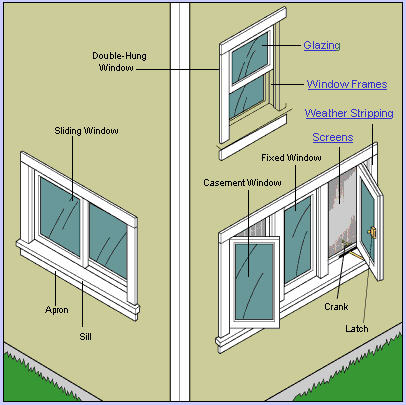
Common window types are:
- Double-hung
- Casement
- Sliders
- Fixed (Picture Window)
- Awning
Frame Materials include:
- Wood
- Vinyl
- Metal
- Wood-Clad
Glass/Glazing Types include:
- Single Pane
- Thermal Pane (generally, 2 panes)
- Triple Pane (two panes of glass with an inner plastic pane, or three panes of glass)
Window Factors
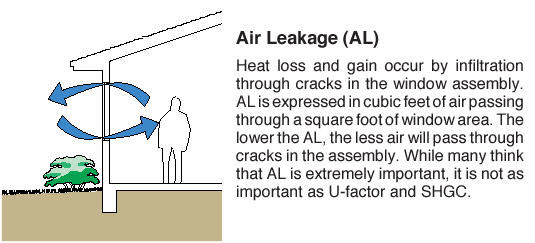
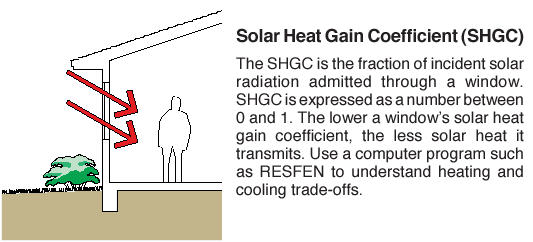
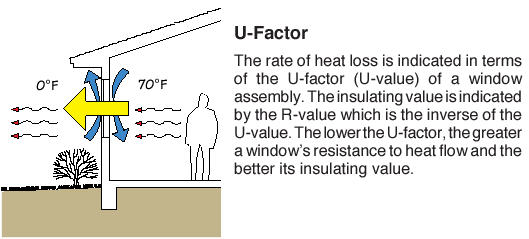

ENERGY STAR Rating
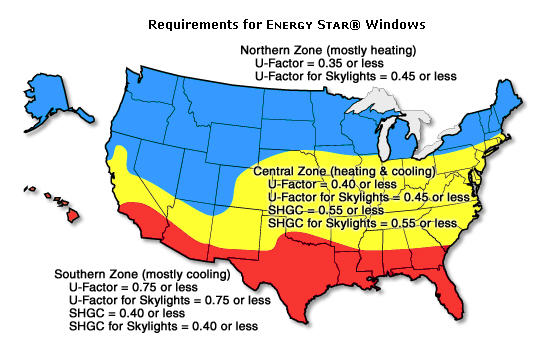
See ENERGY STAR for more information.
 National Fenestration Rating Council
National Fenestration Rating Council
The National Fenestration Rating Council (NFRC) is a nonprofit, public/private organization created by the window, door, and skylight industry. It is composed of manufacturers, suppliers, builders, architects and designers, specifiers, code officials, utilities, and government agencies. The NFRC has developed a window energy rating system based on whole product performance.
The NFRC label provides the only reliable way to determine the window energy properties and to compare products. The NFRC label appears on all products certified to the NFRC standards and on all window, door, and skylight products which are part of the ENERGY STAR® program. At this time, NFRC labels on window units give ratings for U-factor, Solar Heat Gain Coefficient (SHGC), Visible Light Transmittance (VT), and Air Leakage (AL). Soon labels will include an annual heating and cooling rating (HR and CR).
 Weatherstripping
Weatherstripping
New windows have weatherstripping and interlocking seals built into them. They should not require additional or replacement weatherstripping for several years, if ever. Old wood windows must be weatherstripped with after-market products, often every year.
Many types are available for the wide variety of windows and the gap that must be sealed. The important thing is to choose a style that fits the gap but still allows it to operate as needed, and holds up over time.
‘You get what you pay for’ applies to weatherstripping. Some systems are meant to be only a one-season, quick, cheap fix, while other products are meant to last several years.
There are also liquid products that are applied like thick glue. It resembles rubber cement and is designed for one season use. Applied late in the Fall, it seals the gap until the windows are opened in the Spring and the seal is broken.
Rope caulk is an old-timer solution that resembles clay strands about the size of heavy yarn. It is pressed in place by hand and remains pliable for easy removal in the Spring.
Storm Windows
 Storm windows are an important addition to older, single pane windows in northern climates. The oldest storm windows were made of non-operable wood frames. They had to be installed each Fall and removed each Spring in order to open the window. Generally the home owner had two sets of frames, one with glass and one with screens that were changed out each Spring and Fall.
Storm windows are an important addition to older, single pane windows in northern climates. The oldest storm windows were made of non-operable wood frames. They had to be installed each Fall and removed each Spring in order to open the window. Generally the home owner had two sets of frames, one with glass and one with screens that were changed out each Spring and Fall.
The next generation of storm windows were aluminum, operable frame with built-in screens. They were permanently installed over existing single pane windows. Many homes still use this system today. They are a great improvement over single pane windows. They double the R-value and reduce infiltration. However, they tend to steam up, collect a lot of frost, and pretty much date the house as “pre-1970’s”.
Houses with thermal pane windows do NOT require storm windows.
 Do-it-yourself insider storm windows made of plastic sheeting is a low-cost alternative for one season control. To be effective, the plastic must seal all the way around. Double sided tape is the easiest to make the seal. Kits are available that includes everything needed in one box. Shrinking plastic is used to produce a very tight fit that is almost invisible; a hair dryer is used to shrink the plastic after it has been stuck down with double sided tape.
Do-it-yourself insider storm windows made of plastic sheeting is a low-cost alternative for one season control. To be effective, the plastic must seal all the way around. Double sided tape is the easiest to make the seal. Kits are available that includes everything needed in one box. Shrinking plastic is used to produce a very tight fit that is almost invisible; a hair dryer is used to shrink the plastic after it has been stuck down with double sided tape.
Window Treatments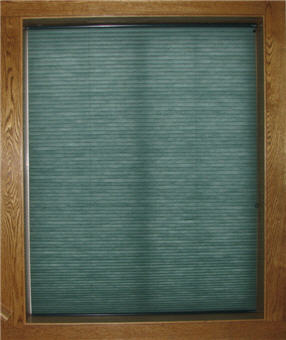
Insulating shades and various types of “home-made” insulating window quilts can substantially reduce the amount of window heat loss. The most difficult part with any type of interior window treatment is blocking the air movement. Window shades that run in tracks or use magnetic seals are the best at stopping air leaks. If the air is not stopped, the value of the shade is reduced and condensation/ice will result on the windows.
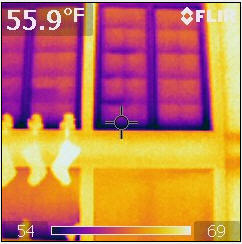
In the IR Image above, the upper windows do
NOT have shades and the lower window do.
More Information
The Efficient Windows Collaborative located at http://www.efficientwindows.org. This is a great site with a LOT of information in layman terms. The Efficient Windows Web Site is sponsored by the U.S. Department of Energy’s Windows and Glazings Program in collaboration with members of the Efficient Window Collaborative (EWC). Technical support for the EWC is provided by Lawrence Berkeley National Laboratory and the University of Minnesota.
The Lawrence Berkeley National Laboratory “Windows and Daylighting” web site athttp://windows.lbl.gov/Default.htm This web site is VERY DEEP and not for the casual user. For comprehensive data window, this is the site to visit.
For more information about installing weatherstripping and storm windows, go to the web sitewww.doityourself.com
Manufacturers
There are hundreds of window manufacturers to select from; some are local specialty companies and others have a national distribution network. Windows should be considered a ‘replacement part’ in a home. Therefore, it is important to select windows from a source that has, and can reasonably be expected to continue to have, a good warranty and support network. Most reputable manufacturers offer a lifetime warranty on thermal seal leakage. Some even include labor. If a window is broken, it is far easier and less expensive to get a replacement component from the window manufacturer than to replace the entire window with someone else’s unit.
See the Manufacturer’s listing and links from the Efficient Window Collaborative’s web site atwww.efficientwindows.org/members_mfgr.cfm for a good selection.
Source: Window Type Graphics from MSN web site at http://houseandhome.msn.com/default.aspx 9/2003; Window Factor Graphics from www.efficientwindows.org web site 9/2003; Text by Bob Fegan 12/2008; IR and window photos by Bob Fegan;
© 2008 Energy Solutions Center400 N. Capitol Street NWWashington, DC 20001 All rights reserved. Legal Contact our webmaster
